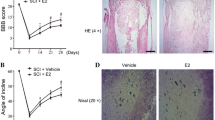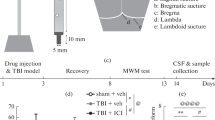Abstract
Isopsoralen is a type of furocoumarin that exhibits estrogen-like activities. The aim of this study was to determine the estrogen-like neuroprotection of isopsoralen in an animal model of spinal cord injury (SCI). Results indicated that isopsoralen (intraperitoneal injection of 5 and 10 mg/kg per day for two weeks) significantly enhanced the hindlimb locomotor functions of mice with SCI, as revealed in the BMS score and angle of inclined plane tests. Morphological data showed that isopsoralen significantly attenuated the injury of the gray matter of spinal cord and induced the up-regulation of ERα levels. The neuroprotective effects of isopsolaren were blocked by the ERα antagonist MPP (0.3 mg/kg), but not by the ERβ receptor antagonist PHTPP (0.3 mg/kg). Isopsolaren treatment increased phosphorylated PI3K and AKT (P-PI3K and P-AKT) in the spinal cord of SCI mice and showed a significant anti-apoptotic activity. These results suggest that isopsoralen performs estrogen-like neuroprotection against SCI-induced apoptosis by activating ERα and regulating the PI3K/AKT pathway.






Similar content being viewed by others
References
Alexander JK, Popovich PG (2009) Neuroinflammation in spinal cord injury: therapeutic targets for neuroprotection and regeneration. Prog Brain Res 175:125–137
Antignani A, Youle RJ (2006) How do Bax and Bak lead to permeabilization of the outer mitochondrial membrane? Curr Opin Cell Biol 18:685–689
Basso DM, Fisher LC, Anderson AJ, Jakeman LB, McTigue DM, Popovich PG (2006) Basso Mouse Scale for locomotion detects differences in recovery after spinal cord injury in five common mouse strains. J Neurotrauma 23:635–659
Beattie MS (2004) Inflammation and apoptosis: linked therapeutic targets in spinal cord injury. Trends Mol Med 10:580–583
Brazil DP, Yang ZZ, Hemmings BA (2004) Advances in protein kinase B signalling: AKTion on multiple fronts. Trends Biochem Sci 29:233–242
Campbell RA, Bhat-Nakshatri P, Patel NM, Constantinidou D, Ali S, Nakshatri H (2001) Phosphatidylinositol 3-kinase/AKT-mediated activation of estrogen receptor alpha: a new model for anti-estrogen resistance. J Biol Chem 276:9817–9824
Chaovipoch P, Jelks KA, Gerhold LM, West EJ, Chongthammakun S, Floyd CL (2006) 17beta-estradiol is protective in spinal cord injury in post- and pre-menopausal rats. J Neurotrauma 23:830–852
Fawcett JW, Curt A, Steeves JD, Coleman WP, Tuszynski MH, Lammertse D, Bartlett PF, Blight AR, Dietz V, Ditunno J, Dobkin BH, Havton LA, Ellaway PH, Fehlings MG, Privat A, Grossman R, Guest JD, Kleitman N, Nakamura M, Gaviria M, Short D (2007) Guidelines for the conduct of clinical trials for spinal cord injury as developed by the ICCP panel: spontaneous recovery after spinal cord injury and statistical power needed for therapeutic clinical trials. Spinal Cord 45:190–205
Ghidoni R, Boccardi M, Benussi L, Testa C, Villa A, Pievani M, Gigola L, Sabattoli F, Barbiero L, Frisoni GB, Binetti G (2006) Effects of estrogens on cognition and brain morphology: involvement of the cerebellum. Maturitas 54:222–228
Hein AL, Ouellette MM, Yan Y (2014) Radiation-induced signaling pathways that promote cancer cell survival (review). Int J Oncol 45:1813–1819
Hou X, Zhao M, Wang T, Zhang G (2014) Upregulation of estrogen receptor mediates migration, invasion and proliferation of endometrial carcinoma cells by regulating the PI3K/AKT/mTOR pathway. Oncol Rep 31:1175–1182
Joshi M, Fehlings MG (2002) Development and characterization of a novel, graded model of clip compressive spinal cord injury in the mouse: Part 1. Clip design, behavioral outcomes, and histopathology. J Neurotrauma 19:175–190
Kan WH, Hsu JT, Schwacha MG, Choudhry MA, Bland KI, Chaudry IH (2008) Estrogen ameliorates trauma-hemorrhage-induced lung injury via endothelial nitric oxide synthase-dependent activation of protein kinase G. Ann Surg 248:294–302
Lee SM, Yune TY, Kim SJ, Park DW, Lee YK, Kim YC, Oh YJ, Markelonis GJ, Oh TH (2003) Minocycline reduces cell death and improves functional recovery after traumatic spinal cord injury in the rat. J Neurotrauma 20:1017–1027
Liu F, Sun GQ, Gao HY, Li RS, Soromou LW, Chen N, Deng YH, Feng HH (2013) Angelicin regulates LPS-induced inflammation via inhibiting MAPK/NF-kappaB pathways. J Surg Res 185:300–309
Miksicek RJ (1995) Estrogenic flavonoids: structural requirements for biological activity. Proc Soc Exp Biol Med 208:44–50
Nesic-Taylor O, Cittelly D, Ye Z, Xu GY, Unabia G, Lee JC, Svrakic NM, Liu XH, Youle RJ, Wood TG, McAdoo D, Westlund KN, Hulsebosch CE, Perez-Polo JR (2005) Exogenous Bcl-xL fusion protein spares neurons after spinal cord injury. J Neurosci Res 79:628–637
Paruthiyil S, Parmar H, Kerekatte V, Cunha GR, Firestone GL, Leitman DC (2004) Estrogen receptor beta inhibits human breast cancer cell proliferation and tumor formation by causing a G2 cell cycle arrest. Cancer Res 64:423–428
Qiu J, Nesic O, Ye Z, Rea H, Westlund KN, Xu GY, McAdoo D, Hulsebosch CE, Perez-Polo JR (2001) Bcl-xL expression after contusion to the rat spinal cord. J Neurotrauma 18:1267–1278
Samantaray S, Sribnick EA, Das A, Thakore NP, Matzelle D, SP Y, Ray SK, Wei L, Banik NL (2010) Neuroprotective efficacy of estrogen in experimental spinal cord injury in rats. Ann N Y Acad Sci 1199:90–94
Sato A, Ohtaki H, Tsumuraya T, Song D, Ohara K, Asano M, Iwakura Y, Atsumi T, Shioda S (2012) Interleukin-1 participates in the classical and alternative activation of microglia/macrophages after spinal cord injury. J Neuroinflammation 9:65
Sedy J, Urdzikova L, Jendelova P, Sykova E (2008) Methods for behavioral testing of spinal cord injured rats. Neurosci Biobehav Rev 32:550–580
Simoben CV, Ibezim A, Ntie-Kang F, Nwodo JN, Lifongo LL (2015) Exploring cancer therapeutics with natural products from African medicinal plants, part I: Xanthones, quinones, steroids, coumarins, Phenolics and other classes of compounds. Anti Cancer Agents Med Chem 15:1092–1111
Springer JE (2002) Apoptotic cell death following traumatic injury to the central nervous system. J Biochem Mol Biol 35:94–105
Stoica GE, Franke TF, Moroni M, Mueller S, Morgan E, Iann MC, Winder AD, Reiter R, Wellstein A, Martin MB, Stoica A (2003) Effect of estradiol on estrogen receptor-alpha gene expression and activity can be modulated by the ErbB2/PI 3-K/Akt pathway. Oncogene 22:7998–8011
Wang Y, Sun ZY, Zhang KM, GQ X, Li G (2011) Bcl-2 in suppressing neuronal apoptosis after spinal cord injury. World J Emerg Med 2:38–44
Weaver FM, Burns SP, Evans CT, Rapacki LM, Goldstein B, Hammond MC (2009) Provider perspectives on soldiers with new spinal cord injuries returning from Iraq and Afghanistan. Arch Phys Med Rehabil 90:517–521
Xin D, Wang H, Yang J, YF S, Fan GW, Wang YF, Zhu Y, Gao XM (2010) Phytoestrogens from Psoralea corylifolia reveal estrogen receptor-subtype selectivity. Phytomedicine 17:126–131
Yune TY, Kim SJ, Lee SM, Lee YK, Oh YJ, Kim YC, Markelonis GJ, Oh TH (2004) Systemic administration of 17beta-estradiol reduces apoptotic cell death and improves functional recovery following traumatic spinal cord injury in rats. J Neurotrauma 21:293–306
Zhang X, Chen Y, Jenkins LW, Kochanek PM, Clark RS (2005) Bench-to-bedside review: apoptosis/programmed cell death triggered by traumatic brain injury. Crit Care 9:66–75
Zhang L, DS X, Feng Y (2007) Study on adscription of plasma effective constituents of rat after administrated with Paeonia lacliflora and Glycyrrhiza Uralensis compound. Zhongguo Zhong Yao Za Zhi 32:1789–1791
Ziu M, Fletcher L, Savage JG, Jimenez DF, Digicaylioglu M, Bartanusz V (2014) Spatial and temporal expression levels of specific microRNAs in a spinal cord injury mouse model and their relationship to the duration of compression. The spine journal: official journal of the North American Spine Society 14:353–360
Acknowledgments
This work was supported by grants from the National Natural Science Foundation of China (31271144, 81325022) awarded to MG Zhao. Clinical Science and Technology Project Funding in Jiangsu Province (No. BL2012002) awarded to JN Zhao. Six Talent Project in Jiangsu Province (No. WSW-091) awarded to G Liu.
Author information
Authors and Affiliations
Corresponding authors
Ethics declarations
Conflict of Interest
The authors declare that they have no conflict of interest.
Additional information
Xiao-ming Li, Qi Yang, Xu-bo Li and Qiang Cheng contributed equally to this work.
Rights and permissions
About this article
Cite this article
Li, Xm., Yang, Q., Li, Xb. et al. Estrogen-like neuroprotection of isopsoralen against spinal cord injury through estrogen receptor ERα. Metab Brain Dis 32, 259–265 (2017). https://doi.org/10.1007/s11011-016-9913-z
Received:
Accepted:
Published:
Issue Date:
DOI: https://doi.org/10.1007/s11011-016-9913-z




